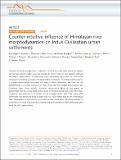Counter-intuitive influence of Himalayan river morphodynamics on Indus Civilisation urban settlements
Abstract
Urbanism in the Bronze-age Indus Civilisation (~4.6–3.9 thousand years before the present, ka) has been linked to water resources provided by large Himalayan river systems, although the largest concentrations of urban-scale Indus settlements are located far from extant Himalayan rivers. Here we analyse the sedimentary architecture, chronology and provenance of a major palaeochannel associated with many of these settlements. We show that the palaeochannel is a former course of the Sutlej River, the third largest of the present-day Himalayan rivers. Using optically stimulated luminescence dating of sand grains, we demonstrate that flow of the Sutlej in this course terminated considerably earlier than Indus occupation, with diversion to its present course complete shortly after ~8 ka. Indus urban settlements thus developed along an abandoned river valley rather than an active Himalayan river. Confinement of the Sutlej to its present incised course after ~8 ka likely reduced its propensity to re-route frequently thus enabling long-term stability for Indus settlements sited along the relict palaeochannel.
Citation
Singh , A , Thomsen , K J , Sinha , R , Buylaert , J-P , Carter , A , Mark , D F , Mason , P J , Densmore , A L , Murray , A S , Jain , M , Paul , D & Gupta , S 2017 , ' Counter-intuitive influence of Himalayan river morphodynamics on Indus Civilisation urban settlements ' , Nature Communications , vol. 8 , 1617 . https://doi.org/10.1038/s41467-017-01643-9
Publication
Nature Communications
Status
Peer reviewed
ISSN
2041-1723Type
Journal article
Description
We acknowledge seed grants from the Leverhulme Trust, Royal Society and UKIERI. Natural Environment Research Council Argon Isotope Facility grant IP-1267-1111 funded the argon analyses. A.S. was supported by a IIT-K PhD fellowship. J-P.B. receives funding from the European Research Council (ERC) under the European Union’s Horizon 2020 research and innovation programme ERC-2014-StG 639904 – RELOS.Collections
Items in the St Andrews Research Repository are protected by copyright, with all rights reserved, unless otherwise indicated.

